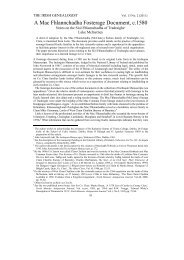Report Cover Vol I - Clare County Library
Report Cover Vol I - Clare County Library
Report Cover Vol I - Clare County Library
Create successful ePaper yourself
Turn your PDF publications into a flip-book with our unique Google optimized e-Paper software.
The <strong>County</strong> <strong>Clare</strong> Wetlands Survey Patrick Crushell & Peter Foss 2008<br />
____________________________________________________________________________________<br />
1.4 Other reports holding wetland information on <strong>Clare</strong><br />
A series of other reports holding information on a limited number of wetland sites in <strong>County</strong> <strong>Clare</strong> were<br />
consulted. A full list of these reports, studies and surveys can be seen in CWS Appendix 1.<br />
In the case of each report the sites listed in <strong>County</strong> <strong>Clare</strong> were screened against the existing sites in the<br />
CWS database. If a site was not located within the CWS database, a new database site record was<br />
created.<br />
In the case of both new and existing site records, data on the scientific interest present on the site,<br />
previous research source, habitats present, and basic site information was recorded within the CWS<br />
database.<br />
The data for these sites was imported manually from the various published reports.<br />
2.1 Sites from CWS site database<br />
2 CWS GIS Database<br />
A shapefile was created from an Microsoft Excel spreadsheet exported from the CWS site database. This<br />
dataset contained point information showing the location of each CWS site recorded from the extensive<br />
literature search and input from third parties.<br />
Each point denoting a site had basic site information (originating from CWS site database) associated<br />
with recorded in various attribute fields including CWS site name, CWS site code, designation etc. The<br />
location of each point was subsequently checked using GIS to ensure that grid references were correct.<br />
2.2 Designated sites – NHA/SAC/SPA<br />
Site boundary files for all existing NHA, SAC and SPA site in <strong>County</strong> <strong>Clare</strong> were obtained from NPWS and<br />
directly imported into the CWS GIS. These boundary files were subsequently used to denote the<br />
boundaries of many CWS sites (those lying within designated sites). Where a CWS site was found to lie<br />
within a designated site, the boundary of the appropriate designated site was exported into a CWS site<br />
boundary shape-file. This shapefiles has a number of attributes including; source of the boundary, CWS<br />
site Code(s), calculated area, X_coord (easting), Y_coord (northing) of the polygon centroid.<br />
In many cases, CWS sites had no existing boundaries associated with them especially in the cases where:<br />
they lay within a large designated site complex; or sites that had never been previously mapped<br />
(including many cNHA’s). In the case where sites were contained within much larger designated sites,<br />
individual boundaries were not drawn, but the subsites were recorded in the attributes of the larger<br />
boundary. In the case where sites were outside of existing boundaries, a boundary was generated where<br />
on inspection the site was clearly visible on the aerial photograph and other base-maps.<br />
Unfortunately, in some cases, CWS sites do not have boundaries associated with them as it was not<br />
possible to confirm the wetland area by referring to the relevant base-maps and background site data<br />
available.<br />
2.3 Habitat type datasets<br />
Many existing datasets (as listed in Appendix 1) were imported directly into the CWS GIS. Each habitat<br />
unit was then exported from its source into a CWS habitat (polygon) shapefile. This shapefile had a<br />
number of attribute fields associated with it including source, area and habitat type recorded as the alpha<br />
numeric code assigned by Fossitt (2000). Due to the different sources of the data it was often necessary<br />
to transform the habitat data into an appropriate Fossitt category. Where it was not possible to attain<br />
level 1 in Fossitt, then the habitat was assigned into a category ‘CWS unknown wetland type’.<br />
In the case of rivers, data was extracted from one primary source and imported into a separate CWS<br />
(linear) shapefile. Similarly with springs, the data was displayed in a separate (point) shapefile. The<br />
same attributes were assigned to these shapefiles as the polygon one above.<br />
83
















